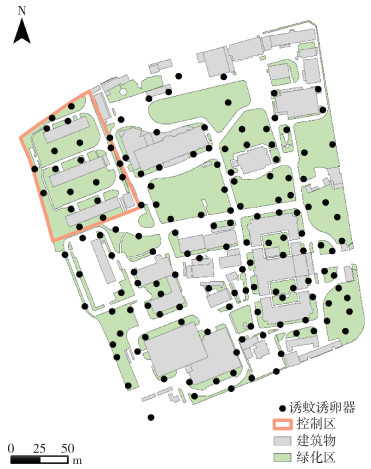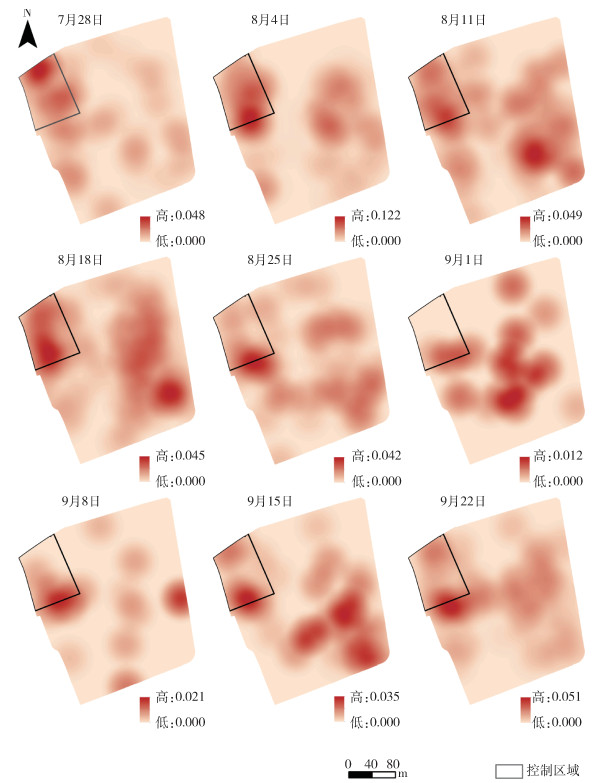
扩展功能
文章信息
- 朱伟, 刘翔宇, 周毅彬
- ZHU Wei, LIU Xiang-yu, ZHOU Yi-bin
- 绿篱喷洒控制白纹伊蚊密度的时空变化研究
- Spatiotemporal variation of Aedes albopictus density treated by hedgerow spraying
- 中国媒介生物学及控制杂志, 2021, 32(6): 772-778
- Chin J Vector Biol & Control, 2021, 32(6): 772-778
- 10.11853/j.issn.1003.8280.2021.06.022
-
文章历史
- 收稿日期: 2021-02-18
2 上海市疾病预防控制中心传染病防治所, 上海 200336
2 Division of Infectious Diseases Control and Prevention, Shanghai Municipal Center for Disease Control and Prevention, Shanghai 200336, China
登革热是一种由伊蚊传播的疾病,近几十年发病率大幅度升高,已成为影响人类健康的主要疾病之一[1],全球约有50%的人口处于登革热发生的风险区[2]。2019年中国大陆28个省级行政区共报告登革热病例22 599例,明显高于2018年的5 136例[3]。在上海地区,白纹伊蚊(Aedes albopictus)是登革热的唯一传播媒介,因此其种群动态分析在登革热预测预警中具有重要意义[4]。登革热疫情的发生和发展过程具有时间和空间特征[5],有研究将空间分析方法用于模拟和研究登革热的时空过程与趋势[6],且逐渐应用于白纹伊蚊密度的监测[7-8]。
滞留喷洒是通过将杀虫剂直接喷洒在蚊虫停落或栖息的物体表面来防制蚊虫的控制方法[9],除了室内外的墙壁等,还包括外环境中各类草丛、灌木丛等绿色植物构成的绿化地带(绿篱)。绿篱滞留喷洒技术是根据蚊虫特点将长效杀虫剂喷洒在建筑物周围的绿植叶片表面,对蚊虫密度抑制效果显著,且具有较好的持效性。有研究表明,绿篱喷洒后2周内蚊虫相对密度下降率 > 80%,第3、4周下降率 > 70%[10]。但目前尚缺乏绿篱喷洒控制时空变化方面的研究。
白纹伊蚊密度变化受到气象、环境和人为因素等影响[11],本研究采用绿篱喷洒技术在一定范围内实施蚊虫防制措施,并使用诱蚊诱卵器法监测白纹伊蚊的种群动态,利用空间分析方法探索绿篱喷洒控制白纹伊蚊密度效果的时空变化,为登革热疫情防控提供方法参考。
1 材料与方法 1.1 研究区域在上海市中心城区选取1个科教园区设为对照区、1个居民小区设为控制区,整体呈矩形,东西长约250 m、南北长约290 m,总面积约7.25万m2。对照区约6.60万m2,内有11幢科研教学楼,食堂、垃圾站、液氮房和地下停车库各1个,设132个监测点,控制区约0.65万m2,内有3幢居民楼,设18个监测点,共计150个监测点。见图 1。

|
| 图 1 2020年上海市绿篱喷洒控制白纹伊蚊研究区域与诱蚊诱卵器监测点位置 Figure 1 Study area and mosquito ovitrap surveillance sites for Aedes albopictus control by hedgerow spraying, Shanghai, 2020 |
| |
本研究使用诱蚊诱卵器法监测白纹伊蚊密度。使用的诱蚊诱卵器符合《GB/T 23797—2009病媒生物密度监测方法蚊虫》的标准。使用时在瓶内倒入约20 ml脱氯水,放入1张滤纸,滤纸浸湿并浮于水的上方。在每个监测点布放1只诱蚊诱卵器,连续放置7 d后回收。
本研究采用绿篱喷洒技术作为控制处理方法。杀虫剂为“都灭”牌顺式氯氰菊酯(有效含量50 g/L)悬浮剂,具有触杀作用、低毒且广泛使用的特点[12]。施药器械为“丸山”牌背负式机动喷雾器(型号MD8100)。根据使用说明书先将药剂稀释200倍(即浓度为0.025%)。风速 < 0.2 m/s时,操作人员以约1.0 m/s的速度行进[13],在控制区内建筑物周围3 m以下的灌木、树干等植被表面喷洒杀虫剂,喷雾器雾滴粒径控制在50~100 μm范围,流量约为0.3 L/min,从植被下层向上均匀喷洒于叶片背面,尽可能使药液在叶片上湿而不滴[10]。
1.3 研究时间与频次2020年7月28日至9月29日共监测9次,每次7 d。分别在第5、6次监测开始放置诱蚊诱卵器前1 h在控制区内实施绿篱喷洒。
1.4 阳性判断标准及计算方法诱蚊诱卵器内有成蚊和/或蚊卵为阳性;既无成蚊也无蚊卵为阴性;丢失、干涸或破损的诱蚊诱卵器为无效。对阳性诱蚊诱卵器内蚊卵计数。诱蚊诱卵指数(MOI)=(阳性诱蚊诱卵器个数/回收诱蚊诱卵器总数)×100[14],使用标准误(Sp)表示样本均数离散程度;平均卵粒数=捕获的总卵粒数/诱蚊诱卵器回收个数;相对密度指数(RPI)=(对照区处理前密度值×控制区处理后某时密度值)/(对照区处理后某时密度值×控制区处理前密度值)×100,当RPI < 50为效果明显,≥100为无效,其数值越小表示处理效果越好[15]。
1.5 空间分析使用ArcGIS 10.8软件进行空间分析。通过全局Moran’s Ⅰ指数进行全局空间自相关分析[16],核密度分析估计卵粒数的密度[17],标准差椭圆分析监测点位置和平均卵粒数的空间方向分布[18]。通过Getis-Ord G系数(Getis-Ord Gi*)进行热点探索[19]。P < 0.05为差异有统计学意义。
2 结果 2.1 诱蚊诱卵器监测结果MOI变化见图 2。控制区的MOI普遍高于对照区,最高峰均出现在第4次监测,MOI分别为88.89±7.41和53.08±4.38。在实施第2次绿篱喷洒(即第6次监测前1 h)之后,控制区的MOI下降至16.67±8.78,低于对照区,之后再次上升,依然高于对照区。

|
| 图 2 2020年上海市绿篱喷洒控制白纹伊蚊实验期间诱蚊诱卵指数变化 Figure 2 Change in mosquito ovitrap index during the experiment of hedgerow spraying for Aedes albopictus control, Shanghai, 2020 |
| |
MOI和RPI见表 1。绿篱喷洒处理前(第1~4次监测)平均MOI为控制前密度值。对照区处理前密度值为40.59,控制区为72.22,在实施第1次绿篱喷洒后,RPI为77.76,实施第2次喷洒后,RPI为25.23,此后3次监测的RPI均 > 50.00。

|
卵粒数的增量空间自相关分析结果见表 2。单个监测点平均卵粒数分布的全局空间自相关峰值半径(Z值最大)为45 m,Moran’s I指数为0.192,Z值为5.848(P < 0.001),即平均卵粒数的空间自相关在半径45 m达到最大值。

|
卵粒数核密度分析和热点探索结果分别见图 3、4。第1~4次监测,控制区的核密度分析颜色相近,高聚集区较多,第5、6次监测(即实施绿篱喷洒后),控制区整体颜色变浅,高聚集区减少,但控制区南部边界处颜色变化很小,且始终存在高聚集区,此后的3次监测,控制区的核密度颜色和高聚集区逐渐恢复到先前水平。

|
| 图 3 2020年上海市绿篱喷洒控制白纹伊蚊实验期间诱蚊诱卵器卵粒数核密度变化 Figure 3 Kernel density variation of egg number in mosquito ovitrap during the experiment of hedgerow spraying for Aedes albopictus control, Shanghai, 2020 |
| |

|
| 图 4 2020年上海市绿篱喷洒控制白纹伊蚊实验期间卵粒数的热点探索变化(搜索半径45 m) Figure 4 Variation chart of hotspot exploration for egg number (radius 45 m) of hedgerow spraying for Aedes albopictus control, Shanghai, 2020 |
| |
根据对照区监测点位置和平均卵粒数进行标准差椭圆分析,结果显示,第1~5次监测的方位角呈现“东南—西北”方向,而第6次监测的方位角呈现“西南—东北”方向,此后3次监测皆呈现“东南—西北”方向。见图 5。

|
| 图 5 2020年上海市绿篱喷洒控制白纹伊蚊实验期间对照区平均卵粒数空间分布方向变化 Figure 5 Variation chart of spatial distribution direction of mean egg number in control area of hedgerow spraying for Aedes albopictus control, Shanghai, 2020 |
| |
滞留性喷洒是使用最为广泛和普遍的成蚊的化学防制技术之一[12, 15, 20]。绿篱喷洒作为滞留性喷洒的分支,是一种新兴技术。本研究的时间为上海地区的蚊虫密度高峰期[21],期间使用诱蚊诱卵器法开展监测9次,对控制区实施绿篱喷洒处理植被2次,并利用阳性诱蚊诱卵器内平均卵粒数分析白纹伊蚊密度的时空变化。
本研究采用浓度为0.025%的顺式氯氰菊酯,处理约1 000 m2的低矮植被和灌木丛等绿篱,处理后的实际有效成分剂量约为20 mg/m2。绿篱喷洒分别在第5、6次监测开始布放诱蚊诱卵器前1 h实施。实施第1次喷洒后RPI > 50.00,控制区蚊密度下降不明显,第2次喷洒之后RPI < 50.00,控制区蚊密度下降明显,即绿篱喷洒可降低白纹伊蚊密度。有研究表明[13],实施绿篱喷洒1周后开始显现控制效果,与本次研究结果一致。终止绿篱喷洒后,1周内蚊虫密度开始回升并逐渐增高,虽然仍低于控制前的密度,但RPI > 50.00,与“1次喷药持效至少1个月”的研究结论[13]不一致。可能的原因是上海市区2020年9月中旬连续阴雨天气冲刷掉了绿篱上的杀虫药物,导致蚊密度在短时间内迅速升高。
阳性诱蚊诱卵器平均卵粒数的空间自相关在半径45 m达到最大值,即研究区域内白纹伊蚊的平均活动范围约为半径45 m,略小于白纹伊蚊50~100 m的一般活动范围[22]。本研究区域位于市中心,建筑物密集且高大,人群较密集,可能会影响蚊虫的飞行方向及距离[23]。
在实施第2次绿篱喷洒后,对照区平均卵粒数标准差椭圆分析方位角从“东南—西北”方向变为“西南—东北”方向,此后1周内又迅速恢复,且控制区南部边界地带卵粒数核密度分析和卵粒数热点探索结果变化较小,说明一个区域内白纹伊蚊的分布模式会被周边白纹伊蚊密度变化所影响。结合白纹伊蚊空间自相关峰值半径为45 m的结论,在进行白纹伊蚊的密度控制时,应在控制区域向外至少45 m的范围设置缓冲区域,同时实施喷洒,以防止因周边白纹伊蚊的扩散导致控制区域的蚊密度增高。
本研究显示,在使用绿篱喷洒技术控制蚊虫时,应至少每周喷洒1次,连续喷洒2周以上,其对白纹伊蚊的抑制效果显著。同时,为避免周边白纹伊蚊的影响,应在控制区域向外至少45 m的缓冲区域一同实施控制措施,以此提高控制效率。
利益冲突 无
| [1] |
Morin CW, Comrie AC, Ernst K. Climate and dengue transmission: evidence and implications[J]. Environ Health Perspect, 2013, 121(11/12): 1264-1272. DOI:10.1289/ehp.1306556 |
| [2] |
孟凤霞, 王义冠, 冯磊, 等. 我国登革热疫情防控与媒介伊蚊的综合治理[J]. 中国媒介生物学及控制杂志, 2015, 26(1): 4-10. Meng FX, Wang YG, Feng L, et al. Review on dengue prevention and control and integrated mosquito management in China[J]. Chin J Vector Biol Control, 2015, 26(1): 4-10. DOI:10.11853/j.issn.1003.4692.2015.01.002 |
| [3] |
刘起勇. 我国登革热流行新趋势、防控挑战及策略分析[J]. 中国媒介生物学及控制杂志, 2020, 31(1): 1-6. Liu QY. Dengue fever in China: new epidemical trend, challenges and strategies for prevention and control[J]. Chin J Vector Biol Control, 2020, 31(1): 1-6. DOI:10.11853/j.issn.1003.8280.2020.01.001 |
| [4] |
梁琳琳, 李晓宁, 罗雷, 等. 广州市2016-2017年白纹伊蚊密度及登革热传播风险分析[J]. 中华卫生杀虫药械, 2019, 25(2): 148-152. Liang LL, Li XN, Luo L, et al. Analysis on the density of Aedes albopictus and the risk of dengue fever transmission in Guangzhou city from 2016 to 2017[J]. Chin J Hyg Insect Equip, 2019, 25(2): 148-152. DOI:10.19821/j.1671-2781.2019.02.017 |
| [5] |
樊景春, 林华亮, 吴海霞, 等. 广东省2006-2011年登革热时空分布特征[J]. 中国媒介生物学及控制杂志, 2013, 24(5): 389-391. Fan JC, Lin HL, Wu HX, et al. Spatial and temporal distribution characteristics of dengue fever in Guangdong province, China during 2006-2011[J]. Chin J Vector Biol Control, 2013, 24(5): 389-391. DOI:10.11853/j.issn.1003.4692.2013.05.003 |
| [6] |
任红艳, 吴伟, 李乔玄, 等. 基于反向传播神经网络模型的广东省登革热疫情预测研究[J]. 中国媒介生物学及控制杂志, 2018, 29(3): 221-225. Ren HY, Wu W, Li QX, et al. Prediction of dengue fever based on back propagation neural network model in Guangdong, China[J]. Chin J Vector Biol Control, 2018, 29(3): 221-225. DOI:10.11853/j.issn.1003.8280.2018.03.001 |
| [7] |
易彬樘, 徐德忠, 张治英, 等. 广东省潮州市伊蚊媒介的地理信息系统建立与应用[J]. 中华流行病学杂志, 2004, 25(2): 134-137. Yi BT, Xu DZ, Zhang ZY, et al. Development and application of geographic information system of Aedes vector in Chaozhou city, Guangdong province[J]. Chin J Epidemiol, 2004, 25(2): 134-137. DOI:10.3760/j.issn:0254-6450.2004.02.012 |
| [8] |
朱伟, 戈斌, 李澜, 等. 空间分析在诱蚊诱卵器监测中的应用研究[J]. 寄生虫与医学昆虫学报, 2020, 27(3): 158-163. Zhu W, Ge B, Li L, et al. The study of the monitoring by mosq-ovitraps with spatial analysis[J]. Acta Parasitol Med Entomol Sin, 2020, 27(3): 158-163. DOI:10.3969/j.issn.1005-0507.2020.03.004 |
| [9] |
冷培恩. 滞留性喷洒技术[J]. 中国媒介生物学及控制杂志, 2004, 15(3): 236-237. Leng PE. Residual spraying technology[J]. Chin J Vector Biol Control, 2004, 15(3): 236-237. DOI:10.3969/j.issn.1003-4692.2004.03.031 |
| [10] |
周小洁, 张勇, 阎婷, 等. 绿篱滞留喷洒对蚊虫防制效果的初步研究[J]. 中国媒介生物学及控制杂志, 2019, 30(6): 653-656. Zhou XJ, Zhang Y, Yan T, et al. A preliminary study on the effect of residual spraying on hedgerow in preventing and controlling mosquitoes[J]. Chin J Vector Biol Control, 2019, 30(6): 653-656. DOI:10.11853/j.issn.1003.8280.2019.06.013 |
| [11] |
周毅彬, 冷培恩, 曹辉, 等. 气温和降雨量对白纹伊蚊密度影响的研究[J]. 中华卫生杀虫药械, 2010, 16(2): 105-107. Zhou YB, Leng PE, Cao H, et al. Study on the influence of temperature and rainfall to Aedes albopictus density[J]. Chin J Hyg Insect Equip, 2010, 16(2): 105-107. DOI:10.19821/j.1671-2781.2010.02.006 |
| [12] |
辛正, 王东, 韩招久, 等. 滞留喷洒技术在病媒生物防治中的应用[J]. 中华卫生杀虫药械, 2016, 22(3): 209-215. Xin Z, Wang D, Han ZJ, et al. Application of residual spraying technology in medical vector control[J]. Chin J Hyg Insect Equip, 2016, 22(3): 209-215. DOI:10.19821/j.1671-2781.2016.03.001 |
| [13] |
晁斌, 阮峰, 崔利伟, 等. 绿蓠技术在社区蚊虫防治中的应用研究[J]. 中华卫生杀虫药械, 2013, 19(6): 494-497. Chao B, Ruan F, Cui LW, et al. Evaluation of insecticidal barrier spray on vegetation for control of mosquitoes in urban community[J]. Chin J Hyg Insect Equip, 2013, 19(6): 494-497. DOI:10.19821/j.1671-2781.2013.06.010 |
| [14] |
中华人民共和国国家质量监督检验检疫总局, 中国国家标准化管理委员会. GB/T 23797-2020病媒生物密度监测方法蚊虫[S]. 北京: 中国标准出版社, 2020. General Administration of Quality Supervision, Inspection and Quarantine of the People's Republic of China, Administration Standardization. GB/T 23797-2020 Surveillance methods for vector density-Mosquito[S]. Beijing: Standards Press of China, 2020. |
| [15] |
刘礼平, 刘旭振, 倪秀锋, 等. 超低容量喷雾防制白纹伊蚊效果研究[J]. 中国媒介生物学及控制杂志, 2017, 28(6): 561-563. Liu LP, Liu XZ, Ni XF, et al. Effectiveness of ultra-low-volume spray application for the control of Aedes albopictus[J]. Chin J Vector Biol Control, 2017, 28(6): 561-563. DOI:10.11853/j.issn.1003.8280.2017.06.011 |
| [16] |
Moran PAP. Notes on continuous stochastic phenomena[J]. Biometrika, 1950, 37(1/2): 17-23. DOI:10.2307/2332142 |
| [17] |
潘梦华, 黄斌, 黎燕宁. 基于核密度和地理探测器的南宁市手足口病空间聚集及影响因素[J]. 中华疾病控制杂志, 2020, 24(11): 1269-1274, 1331. Pan MH, Huang B, Li YN. Analysis of spatial clustering and influencing factors of hand, foot, and mouth disease in Nanning based on nuclear density and geodetector[J]. Chin J Dis Control Prev, 2020, 24(11): 1269-1274, 1331. DOI:10.16462/j.cnki.zhjbkz.2020.11.006 |
| [18] |
董雯, 杨昆, 许泉立. 2013-2014年中国地区人感染H7N9禽流感疫情空间分布格局及时空聚集模式研究[J]. 中华疾病控制杂志, 2017, 21(7): 650-654. Dong W, Yang K, Xu QL. A research on the spatial distribution structure and spatiotemporal clustering of A (H7N9) human infections in China during 2013 and 2014[J]. Chin J Dis Control Prev, 2017, 21(7): 650-654. DOI:10.16462/j.cnki.zhjbkz.2017.07.002 |
| [19] |
高风华, 何家昶, 张世清, 等. 安徽省现症血吸虫病病例分布的空间自相关分析[J]. 中国寄生虫学与寄生虫病杂志, 2019, 37(5): 556-562. Gao FH, He JC, Zhang SQ, et al. Spatial autocorrelation analysis of current schistosomiasis case distribution in Anhui province[J]. Chin J Parasitol Parasit Dis, 2019, 37(5): 556-562. DOI:10.12140/j.issn.1000-7423.2019.05.009 |
| [20] |
蔡松武, 林立丰, 卢文成, 等. 高效氯氰菊酯超低容量喷雾杀灭室外白纹伊蚊的研究[J]. 中国媒介生物学及控制杂志, 2004, 15(6): 439-440. Cai SW, Lin LF, Lu WC, et al. Ultra-low-volume application of beta-cypermethrin for the control of Aedes albopictus in field[J]. Chin J Vector Biol Control, 2004, 15(6): 439-440. DOI:10.3969/j.issn.1003-4692.2004.06.007 |
| [21] |
朱江, 刘洪霞, 刘曜, 等. 上海地区2010-2016年蚊虫监测结果分析[J]. 上海预防医学, 2018, 30(8): 635-639. Zhu J, Liu HX, Liu Y, et al. Mosquito monitoring result analysis in Shanghai, 2010-2016[J]. Shanghai J Prev Med, 2018, 30(8): 635-639. DOI:10.19428/j.cnki.sjpm.2018.18785 |
| [22] |
景晓, 李兆凰, 霍新北, 等. 山东地区白纹伊蚊种群生态特点的比较研究[J]. 中华卫生杀虫药械, 2006, 12(3): 216-218. Jing X, Li ZH, Huo XB, et al. Analysis and study on the population bionomics of the Aedes albopictus in Shandong[J]. Chin J Hyg Insect Equip, 2006, 12(3): 216-218. DOI:10.3969/j.issn.1671-2781.2006.03.019 |
| [23] |
刘起勇, 刘小波, 周广超, 等. 基于标记-释放-重捕技术的中华按蚊飞行距离初步研究[J]. 中国媒介生物学及控制杂志, 2011, 22(3): 201-204. Liu QY, Liu XB, Zhou GC, et al. Primary study on the flight range of Anopheles sinensis based on the mark-release-recapture method in Yongcheng city, Henan province[J]. Chin J Vector Biol Control, 2011, 22(3): 201-204. |
 2021, Vol. 32
2021, Vol. 32




